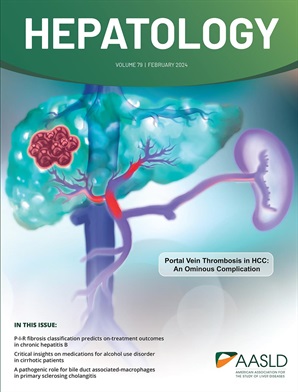Causes of mortality among patients with early-stage hepatocellular carcinoma
IF 15.8
1区 医学
Q1 GASTROENTEROLOGY & HEPATOLOGY
引用次数: 0
Abstract
Background: Early detection of hepatocellular carcinoma (HCC) can reduce cancer-related mortality; however, there are often competing risks from comorbid conditions, including cirrhosis. Understanding causes of death among patients with early-stage HCC can inform strategies to improve surveillance effectiveness. Methods: We conducted a retrospective cohort study of patients with early-stage HCC (BCLC stages 0/A) at four U.S. health systems between 2008 and 2022. We defined the primary cause of death as HCC-related, liver-related (non-HCC), and death from other causes. We used multivariable and Fine-Gray analysis, with liver transplant as a competing outcome, to identify factors associated with mortality. Results: Among 1,336 patients with early-stage HCC, 598 (44.8%) died during a median follow-up of 32.4 months – 220 (37%) HCC-related, 114 (19%) liver-related, and 179 (30%) from other causes. Median time to death was similar between the groups: 24 (95%CI 22-31), 19 (95%CI 15-23), and 23 (95%CI 19-27) months for HCC-related, liver-related, and other causes of mortality, respectively. Curative treatment was associated with reduced HCC-related (HR 0.34; 95%CI 0.23-0.48) and liver-related mortality (HR 0.23; 95%CI 0.14-0.38). Predictors of HCC-related mortality included AFP >20 ng/mL (HR 2.19; 95%CI 1.59-3.03), and tumor diameter >3 cm (HR 1.69; 95%CI 1.20-2.37). Liver-related mortality was associated with MASLD etiology (HR 1.99; 95%CI 1.09-3.65), Child-Pugh B cirrhosis (HR 2.64; 95%CI 1.58-4.42), and ALBI grade 2 (vs. grade 1: HR 2.47; 95%CI 1.21-5.06). Conclusion: Cause of death varies among patients with early-stage HCC, although HCC-related death remains the most common cause. Efforts are needed to optimize curative treatment effectiveness among patients with early-stage HCC to reduce cancer-related mortality.早期肝细胞癌患者死亡原因分析
背景:早期发现肝细胞癌(HCC)可以降低癌症相关死亡率;然而,合并症(包括肝硬化)往往存在相互竞争的风险。了解早期HCC患者的死亡原因可以为提高监测有效性的策略提供信息。方法:我们对2008年至2022年间美国4个卫生系统的早期HCC (BCLC 0/ a期)患者进行了回顾性队列研究。我们将主要死亡原因定义为hcc相关、肝脏相关(非hcc)和其他原因导致的死亡。我们使用多变量和Fine-Gray分析,将肝移植作为竞争结果,以确定与死亡率相关的因素。结果:在1336例早期HCC患者中,598例(44.8%)在32.4个月的中位随访期间死亡,其中220例(37%)与HCC相关,114例(19%)与肝脏相关,179例(30%)死于其他原因。两组之间的中位死亡时间相似:hcc相关、肝脏相关和其他原因的死亡分别为24个月(95%CI 22-31)、19个月(95%CI 15-23)和23个月(95%CI 19-27)。治疗与hcc相关降低相关(HR 0.34;95%CI 0.23-0.48)和肝脏相关死亡率(HR 0.23;95%可信区间0.14 - -0.38)。hcc相关死亡率的预测因子包括:AFP >;20 ng/mL (HR 2.19;95%CI 1.59-3.03),肿瘤直径为3cm (HR 1.69;95%可信区间1.20 - -2.37)。肝脏相关死亡率与MASLD病因相关(HR 1.99;95%CI 1.09-3.65), Child-Pugh B肝硬化(HR 2.64;95%CI 1.58-4.42), ALBI 2级(相对于1级:HR 2.47;95%可信区间1.21 - -5.06)。结论:早期HCC患者的死亡原因各不相同,但HCC相关死亡仍是最常见的原因。需要努力优化早期HCC患者的治疗效果,以降低癌症相关死亡率。
本文章由计算机程序翻译,如有差异,请以英文原文为准。
求助全文
约1分钟内获得全文
求助全文
来源期刊

Hepatology
医学-胃肠肝病学
CiteScore
27.50
自引率
3.70%
发文量
609
审稿时长
1 months
期刊介绍:
HEPATOLOGY is recognized as the leading publication in the field of liver disease. It features original, peer-reviewed articles covering various aspects of liver structure, function, and disease. The journal's distinguished Editorial Board carefully selects the best articles each month, focusing on topics including immunology, chronic hepatitis, viral hepatitis, cirrhosis, genetic and metabolic liver diseases, liver cancer, and drug metabolism.
 求助内容:
求助内容: 应助结果提醒方式:
应助结果提醒方式:


